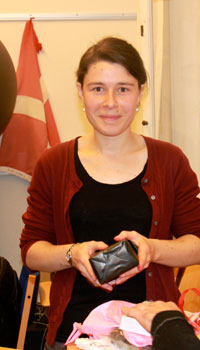Stort tillykke til Myriam Guillevic

Et velfortjent glas fransk champagne skænket af vejleder Thomas Blunier, efter et veloverstået ph.d. forsvar.
Stort tillykke til Myriam Guillevic fra Center for Is og Klima, som med stor succes forsvarede sin ph.d.-afhandling d. 20 november, 2013
 Titel
Titel
Characterization of rapid climate changes through isotope analyses of ice and entrapped air in the NEEM ice core
Abstract
Greenland ice core have revealed the occurrence of rapid climatic instabilities during the last glacial period, known as Dansgaard-Oeschger (DO) events, while marine cores from the North Atlantic have evidenced layers of ice rafted debris deposited by icebergs melt, caused by the collapse of Northern hemisphere ice sheets, known as Heinrich events. The imprint of DO and Heinrich events is also recorded at mid to low latitudes in different archives of the northern hemisphere. A detailed multi-proxy study of the sequence of these rapid instabilities is essential for understanding the climate mechanisms at play.
Recent analytical developments have made possible to measure new paleoclimate proxies in Greenland ice cores. In this thesis we first contribute to these analytical developments by measuring the new innovative parameter 17O-excess at LSCE (Laboratoire des Sciences du Climatet de l'Environnement, France). At the Centre for Ice and Climate (CIC, Denmark) we contribute to the development of a protocol for absolute referencing of methane gas isotopes, and making full air standard with known concentration and isotopic composition of methane.
Then, air (δ15N) and water stable isotope measurements from four Greenland deep ice cores (GRIP, GISP2, NGRIP and NEEM) are investigated over a series of Dansgaard– Oeschger events (DO 8, 9 and 10). Combined with firn modeling, δ15N data allow us to quantify abrupt temperature increases for each drill site (1σ = 0.6°C for NEEM, GRIP and GISP2, 1.5°C for NGRIP). Our data show that the magnitude of stadial–interstadial temperature increase is up to 2°C larger in central and North Greenland than in northwest Greenland. The same spatial pattern is seen for accumulation increases. This pattern is coherent with climate simulations in response to reduced sea-ice extent in the Nordic seas.
Finally, we develop a multi-proxy approach to identify in polar ice cores the fingerprint of Heinrich Events and apply it to Heinrich events 4 and 5, occurring during GS-9 and GS-13 respectively. Our multi-proxy study evidences non-synchronous climate changes between Greenland and the mid-latitudes during GS-9 and GS-13. It opens new paths forparallel investigation of different marine, terrestrial and ice core climate archives.
